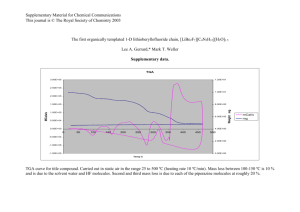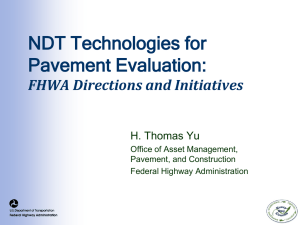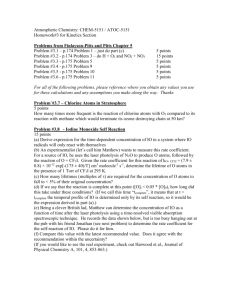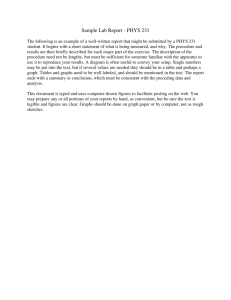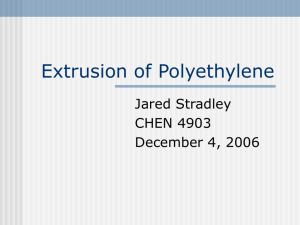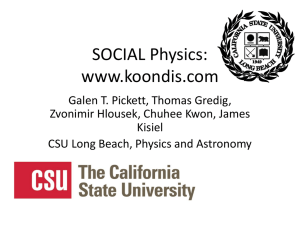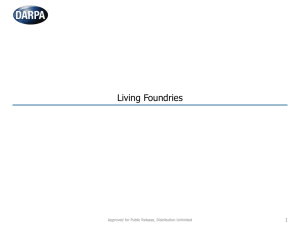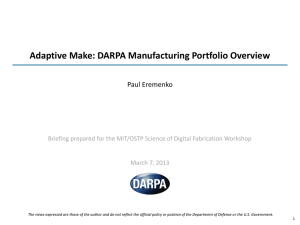Green Engineering
advertisement
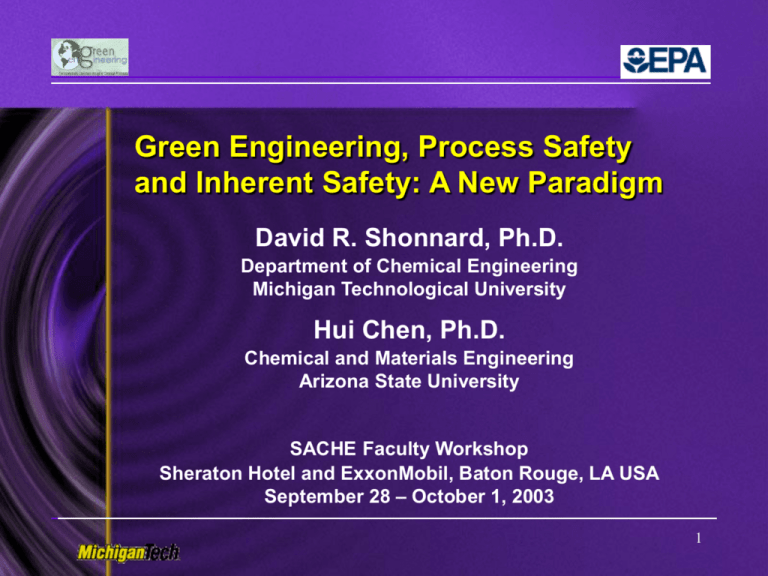
Green Engineering, Process Safety and Inherent Safety: A New Paradigm David R. Shonnard, Ph.D. Department of Chemical Engineering Michigan Technological University Hui Chen, Ph.D. Chemical and Materials Engineering Arizona State University SACHE Faculty Workshop Sheraton Hotel and ExxonMobil, Baton Rouge, LA USA September 28 – October 1, 2003 1 Presentation Outline • Introduction to Green Engineering (GE) and Inherent Safety (IS) – GE definition, concepts, principles, and tools – IS concepts and tools – Similarities and differences between GE and IS • Environmentally-Conscious Process Design Methodology – – – – – – A hierarchical approach with three “tiers” of impact assessment A case study for maleic anhydride (MA) process design Early design methods and software tools Flowsheet synthesis, assessment, and software tools Flowsheet optimization - comparison of process improvement Summary of environmentally-conscious design methods 2 What is Green Engineering? Design, commercialization and use of processes and products that are feasible and economical while minimizing: • + Risk to human health and the environment • + Generation of pollution at the source US EPA, OPPT, Chemical Engineering Branch, Green Engineering Program 3 Why Chemical Processes (USA)? • Positives – 1 million jobs – $477.8 billion to the US economy – 5% of US GDP – + trade balance (in the recent past) – 57% reduction in toxic releases (`88-`00) • Chemical and Engineering News, Vol. 80, No. 25, pp. 42-82, June 24, 2002 • US EPA, Toxics Release Inventory (TRI) Public Data Release, 2000 4 Why Chemical Processes (USA)? • Environmental Challenges – Manufacturing industries in the US (SIC codes 20-39) 1/3 of all TRI releases – Chemical/Petroleum industries about 10% of all TRI releases – Increase of 148% of TRI wastes managed on-site (`91`00) – Chemical products harm the environment during their use – Energy Utilization – ~15% of US consumption • US EPA, Toxics Release Inventory (TRI) Public Data Release, 2000 • US DOE, Annual Energy Review, 1997. 5 Energy Use: U.S. Industry SIC Code 29 Petroleum/Coal Products 28 Chemicals / Allied Products 26 Paper / Allied Products 33 Primary Metals Industries 20 Food / Kindred Products 32 Stone,Clay and Glass 24 Lumber / Wood Products 1015 BTU/yr 6.34 5.33 2.67 2.46 1.19 0.94 0.49 Numbers represent roughly the % of US annual energy consumption Annual Energy Review 1997, U.S. DOE, Energy Information Administration, Washington, DC, DOE/EIA-0384(97) 6 Pollution Prevention (P2) vs. Pollution Control (PC) Traditional Process Products Raw Materials, Energy Chemical Process Pollution Control Wastes Greener Process Products Raw Materials, Energy Modified Chemical Process Higher income, Higher operating costs Pollution Control Lower PC costs Wastes Recycle 7 Examples of Green Engineering • Chemical reactions using environmentally-benign solvents • Improved catalysts – that increase selectivity and reduce wastes – that improve product quality and reduce environmental impacts – that process wastes into valuable products • • • • • • • Separations using supercritical CO2 rather than R-Cl solvents Separative reactors that boost yield and selectivity Fuel cells in transportation and electricity generation CO2 sequestration New designs that integrate mass and energy more efficiently Process modifications that reduce emissions Environmentally-conscious design methods and software tools. 8 Environmentally-Conscious Design • Methods and tools to evaluate environmental consequences of chemical processes and products are needed. – quantify multiple environmental impacts, – guide process and product design activities – improve environmental performance of chemical processes and products • Environmental impacts – energy consumption – impacts to air, water – human health impacts - raw materials consumption - solid wastes - toxic effects to ecosystems • Economic Performance – costs, profitability 9 Tools of Environmentally-Conscious Chemical Process Design and Analysis Chemical Process Properties • thermodynamics • reactions • transport Chemical Process Models • simulation • waste generation and release Environmental Fate Properties • databases • estimation Environmental Fate Models • single compartment • multi-media E-CD Hierarchical Design Process Optimization • multi-objective • mixed integer • non-linear Environmental Impacts Models • midpoint vs endpoint • normalization • valuation Process Integration • mass integration • heat integration 10 Principles of Green Engineering The Sandestin Declaration on Green Engineering Principles Green Engineering transforms existing engineering disciplines and practices to those that lead to sustainability. Green Engineering incorporates development and implementation of products, processes, and systems that meet technical and cost objectives while protecting human health and welfare and elevates the protection of the biosphere as a criterion in engineering solutions. Green Engineering: Defining the Principles, Engineering Conferences International, Sandestin, FL, USA, May 17-22, 2003. 11 Principles of Green Engineering The Sandestin GE Principles 1. 2. 3. 4. 5. 6. 7. 8. 9. Engineer processes and products holistically, use systems analysis, and integrate environmental impact assessment tools. Conserve and improve natural ecosystems while protecting human health and well-being Use life-cycle thinking in all engineering activities Ensure that all material and energy inputs and outputs are as inherently safe and benign as possible Minimize depletion of natural resources Strive to prevent waste Develop and apply engineering solutions, while being cognizant of local geography, aspirations, and cultures Create engineering solutions beyond current or dominant technologies; improve, innovate and invent (technologies) to achieve sustainability Actively engage communities and stakeholders in development of engineering solutions Green Engineering: Defining the Principles, Engineering Conferences International, Sandestin, FL, USA, May 17-22, 2003. 12 Definition of Inherent Safety (IS) A chemical manufacturing process is described as inherently safer if it reduces or eliminates hazards associated with materials used and operations, and this reduction or elimination is a permanent and inseparable part of the process technology. (Kletz, 1991; Hendershot, 1997a, b) 13 IS Concepts • Intensification - using less of a hazardous material Example: improved catalysts can reduce the size of equipment and minimize consequences of accidents. • Attenuation - using a hazardous material in a less hazardous form. Example: larger size of particle for flammable dust or a diluted form of hazardous material like aqueous acid rather than anhydrous acid. • Substitution - using a safer material or production of a safer product. Example: substituting water for a flammable solvent in latex paints compared to oil base paints. 14 IS Concepts (cont.) • limitation - minimizing the effect of an incident. Example: smaller diameter of pipe for transport of toxic gases and liquids will minimize the dispersion of the material when an accident does occur • Simplification - reducing the opportunities for error and malfunction. Example: easier-to-understand instructions to operators. 15 Comparison between IS and (GE) Strategy/Tenet (Based on IS) Example Concepts Inherent Safety (IS) Green Engineering (GE) Substitution Reaction chemistry, Feedstocks, Catalysts, Solvents, Fuel selection √√√√ √√√√ Minimization Process Intensification, Recycle, Inventory reduction, Energy efficiency, Plant location √√√ √√√√ Number of unit operations, DCS configuration, Raw material quality, Equipment design √√√√ √√√√ Moderation (1) [Basic Process] Conversion conditions, Storage conditions, Dilution, Equipment overdesign √√√√ √√√ Moderation (2) [Overall Plant] Offsite reuse, Advanced waste treatment, Plant location, Beneficial codisposal √√√ √√√ Simplification √√√√ = Primary tenet/concepts √√ = Some aspects addressed √√√ = Strongly related tenet/concepts √ = Little relationship 16 Similarities between (GE) and (IS) • Benign and less hazardous materials. • Both focus on process changes. • Improving either one often results in improving the other. • Both use a life-cycle approach. • Both are best considered in the initial stages of the design. 17 Differences between GE & IS • Focus on a different parts of the product life cycle. • Focus on different aspect of EHS (environmental, health and safety) field and may conflict in application. • Environmental impacts are more numerous than safety impacts. 18 Presentation Outline • Introduction to Green Engineering (GE) and Inherent Safety (IS) – GE definition, concepts, principles, and tools – IS concepts and tools – Similarities and differences between GE and IS • Environmentally-Conscious Process Design Methodology – – – – – – A hierarchical approach with three “tiers” of impact assessment A case study for maleic anhydride (MA) process design Early design methods and software tools Flowsheet synthesis, assessment, and software tools Flowsheet optimization - comparison of process improvement Summary of environmentally-conscious design (ECD) methods 19 Scope of environmental impacts Pre-Chemical Manufacturing Stages • Extraction from the environment • Transportation of materials • Refining of raw materials • Storage and transportation • Loading and unloading Chemical Manufacturing Process Post-Chemical Manufacturing Stages • Chemical reactions • Separation operations • Material storage • Loading and unloading • Material conveyance • Waste treatment processes • Final product manufacture • Product usage in commerce • Reuse/recycle • Treatment/destruction • Disposal • Environmental release • Airborne releases wastewater releases • Solid/hazardous waste • Toxic chemical releases • Energy consumption • Resource depletion Environmental/Health Impacts • Global warming • Ozone layer depletion • Air quality – smog • Acidification • Ecotoxicity • Human health effects, carcinogenic and non carcinogenic • Resource depletion 20 Tools of Environmentally-Conscious Chemical Process Design and Analysis Chemical Process Properties • thermodynamics • reactions • transport Chemical Process Models • simulation • waste generation and release Environmental Fate Properties • databases • estimation Environmental Fate Models • single compartment • multi-media E-CD Hierarchical Design Process Optimization • multi-objective • mixed integer • non-linear Environmental Impacts Models • midpoint vs endpoint • normalization • valuation Process Integration • mass integration • heat integration 21 Hierarchical Approach to E-CD Process Design Stages Environmental Assessments Level 1. Input Information problem definition Simple (“tier 1”) toxicity potential, costs Level 2. Input-Output Structure material selection reaction pathways Levels 3 & 4. recycle separation system Levels 5 - 8. energy integration detailed evaluation control safety Douglas, J.M., Ind. Eng. Chem. Res., Vol. 41, No. 25, pp. 2522, 1992 “tier 2” – material/energy intensity, emissions, costs “tier 3” – emissions, environmental fate, risk Allen, D.T. and Shonnard, D.R. Green Engineering : Environmentally Conscious Design of Chemical Processes, 22 Prentice Hall, pg. 552, 2002. Early vs Detailed Design Tasks Chen, H., Rogers, T.N., Barna, B.A., Shonnard, D.R.,, Environmental Progress, in press April, 2003. Initial design task Process synthesis and base case flowsheet development 1. 2. 3. 4. Iterate Reaction pathway evaluation Solvent selection Technology selection Equipment selection Equipment sizing Economic assessment Environmental assessment Scaled gradient analysis Process simulation Multi-objective optimization PDS Life cycle assessment Improved base case flowsheet Optimum Early Design Detailed Design 23 Hierarchical Approach to E-CD Process Design Stages Environmental Assessments Level 1. Input Information problem definition Simple (“tier 1”) toxicity potential, costs Level 2. Input-Output Structure material selection reaction pathways Levels 3 & 4. recycle separation system Levels 5 - 8. energy integration detailed evaluation control safety Douglas, J.M., Ind. Eng. Chem. Res., Vol. 41, No. 25, pp. 2522, 1992 “tier 2” – material/energy intensity, emissions, costs “tier 3” – emissions, environmental fate, risk Allen, D.T. and Shonnard, D.R. Green Engineering : Environmentally Conscious Design of Chemical Processes, 24 Prentice Hall, pg. 552, 2002. Case Study: Maleic Anhydride (MA) Production Level 1. Input / Output Information Benzene Process V2O5-MoO3 2C6 H 6 9O2 2C4 H 2O3 4CO2 4H 2O 2C 6 H 6 9O2 12CO 6H 2 O 2C 6 H 6 15O2 12CO2 6H 2 O C 4 H 2 O3 O2 4CO H 2 O C4 H 2O3 3O2 4CO2 H 2O Benzene conversion, 95% MA Yield, 70% Air/Benzene, ~ 66 (moles) Temperature, 375°C Pressure, 150 kPa n-Butane Process VPO 2C4 H10 7O2 2C4 H 2O3 8H 2O 2C4 H 10 9O2 8CO 10 H 2 O 2C4 H 10 13O2 8CO2 10H 2 O C4 H 2 O3 3O2 4CO2 H 2 O C4 H 2 O3 O2 4CO H 2 O n-butane conversion, 85% MA Yield, 60% Air/n-butane, ~ 62 (moles) Temperature, 400°C Pressure, 150 kPa 25 MA Production: Early Design Costs Level 1. Input / Output Information “Tier 1” Economic analysis (raw materials costs only) Benzene Process (1 mole/0.70 mole) (78 g/mole) (0.00028 $/g) = 0.0312 $/mole of MA MA Yield Bz MW Benzene cost N-butane process has lower cost n-Butane Process (1mole/0.60 mole) (58 g/mole) (0.00021 $/g) = 0.0203 $/mole of MA MA Yield nC4 MW nC4 cost Assumption: raw material costs dominate total cost of the process 26 MA Production: Environmental Impacts Level 1. Input / Output Information “Tier 1” Environmental Impact Analysis • Based on Products and Byproducts from the Reactor • Alternative “tier 1” assessment approaches – Toxicity and stoichiometry – Toxicity, other impact potentials, and stoichiometry – Toxicity, other impact potentials, stoichiometry, and environmental fate – Toxicity, other impact potentials, stoichiometry, environmental fate, and pollution control. 27 MA Production: IO Assumptions Level 1. Input / Output Information “Tier 1” Environmental Impact Analysis CO2, H2O, air, traces of CO, MA benzene, n-butane Unreacted Benzene or n-butane Benzene or n-butane 99% control CO, CO2 , H2O, air, MA Reactor Air Pollution Control MA, CO, CO2 , H2O air Product Recover y 99% MA recovery MA 50x106 lb/yr 28 Emission Estimation Level 1. Input / Output Information “Tier 1” Environmental Impact Analysis • Emissions to Air – Emission factors from US EPA • Reactors, separation devices • Air ClearingHouse for Inventories and Emission Factors • Air CHIEF http://www.epa.gov/ttn/chief/index.html – CO, CO2 generation from the reactor • Benzene process – Benzene: 0.07 moles benzene / mole MA – CO + CO2: 4.1 moles / mole MA • n-butane process – n-butane: 0.25 moles benzene / mole MA – CO + CO2: 1.7 moles / mole MA Conversions, Yields 29 Environmental / Toxicity Properties Level 1. Input / Output Information “Tier 1” Environmental Impact Analysis • Environmental/Toxicological Properties – Estimation Software • EPI (Estimation Program Interface) Suite • http://www.epa.gov/oppt/exposure/docs/episuite.htm • Henry‘s constant, partitioning, degradation, toxicity – Online Database • Environmental Fate Database • http://es.epa.gov/ssds.html Compilation in: Appendix F. Allen, D.T. and Shonnard, D.R., Green Engineering : Environmentally- Conscious Design of Chemical Processes, Prentice Hall, pg. 552, 2002 30 Environmental Fate Calculations Level 1. Input / Output Information “Tier 1” Environmental Impact Analysis Multimedia compartment model Processes modeled • emission inputs, E • advection in and out, DA • intercompartment mass transfer,Di,j • reaction loss, DR Model Domain Parameters • surface area - 104 -105 km2 • 90% land area, 10% water • height of atmosphere - 1 km • soil depth - 10 cm • depth of sediment layer - 1 cm • multiphase compartments Mackay, D. 1991, ”Multimedia Environmental Models", 1st edition,, Lewis Publishers, Chelsea, MI 31 Impact Indicator Calculation Level 1. Input / Output Information “Tier 1” Environmental Impact Analysis Carcinogenic Risk Example (inhalation route) (Ca CR EF ED) SF (BW AT ) i Relative Risk = (Ca CR EF ED) SF (BW AT ) Benchmark = Ca SFi Ca SF Benchmark Multimedia compartment model concentration in air Exposure Factors Carcinogenic Slope Factor, SF (toxicological property) 32 Indicators for the Ambient Environment Level 1. Input / Output Information “Tier 1” Environmental Impact Analysis Relative Risk Index Global Warming The TRACI method and software contains a comprehensive listing of impact categories and indicators. Equation * IGW ,i GWPi * IGW ,i NC Ozone Depletion Smog Formation Acid Rain MWCO2 MWi * IOD,i ODPi * ISF,i MIRi MIRR OG IA* R,i ARPi ARPSO2 GWP = global warming potential, NC = number of carbons atoms, ODP = ozone depletion potental, MIR = maximum incremental reactivity, ARP = acid rain potential. Compilation impact parameters in: Appendix D. Allen, D.T. and Shonnard, D.R., Green Engineering : EnvironmentallyConscious Design of Chemical Processes, Prentice Hall, pg. 552, 2002 33 Indicators of Toxicity Level 1. Input / Output Information “Tier 1” Environmental Impact Analysis Relative Risk Index Human Toxicity Ingestion Route Human Toxicity Inhalation Route Human Carcinogenicity Ingestion Route Human Carcinogenicity Inhalation Route Fish Toxicity The TRACI method and software contains a comprehensive listing of impact categories and indicators. Equation I * IN G CW,i LD50, T oluene CW,T oluene LD50,i CA, i LC50,T oluene * I IN H CA, T oluene LC50,i CW,i HVi I *C IN G CW, Benzene HVBenzene I * CINH CA, i HVi CA,Benzene HVBenzene I * FT CW,i LC50 f , PCP CW, PCP LC50 f ,i LD50 = lethal dose 50% mortality, LC50 = lethal concentration 50% mortality, and HV = hazard value for carcinogenic health effects. 34 Indicators for MA Production Level 1. Input / Output Information “Tier 1” Environmental Impact Analysis N Process Index (I) (Ii *) (mi ) i1 Chemical Benzene n-butane IFT (kg/mole MA) 5.39x10-6 2.19x10-6 IING “ 3.32x10-3 3.11x10-3 IINH “ 8.88x10-2 3.93x10-2 ICING “ 1.43x10-4 0.00 ICINH “ 1.43x10-4 0.00 IOD “ 0.00 0.00 IGW “ 2.01x10-1 1.17x10-1 ISF “ 3.04x10-5 4.55x10-6 IAR “ 0.00 0.00 n-butane process has lower environmental impacts 35 Hierarchical Approach to E-CD Process Design Stages Environmental Assessments Level 1. Input Information problem definition Simple (“tier 1”) toxicity potential, costs Level 2. Input-Output Structure material selection reaction pathways Levels 3 & 4. recycle separation system Levels 5 - 8. energy integration detailed evaluation control safety Douglas, J.M., Ind. Eng. Chem. Res., Vol. 41, No. 25, pp. 2522, 1992 “tier 2” – material/energy intensity, emissions, costs “tier 3” – emissions, environmental fate, risk Allen, D.T. and Shonnard, D.R. Green Engineering : Environmentally Conscious Design of Chemical Processes, 36 Prentice Hall, pg. 552, 2002. Case Study: MA Production Level 3-8. Flowsheet Synthesis and Evaluation “Tier 3” Environmental Impact Analysis • Based on an initial process flowsheet created using “traditional“ economic-based design heuristics. • “tier 3” assessment – Emissions estimation from units and fugitive sources – Environmental fate and transport calculation – Toxicity, other impact potentials, environmental fate and transport, and pollution control. 37 Integrated Process Simulation and Assessment Method and Software SCENE PDS Report SGA Report Stream information HYSYS EFRAT Environmental indices DORT Manipulated variables OPTIMIZER AHP Economic indices Objective function HYSYS – a commercial chemical process simulator software, EFRAT – a software for calculating environmental impacts, DORT - a software to estimate equipment costs and operating costs, AHP (Analytic Hierarchy Process) – multi-objective decision analysis, PDS – Process Diagnostic Summary Tables, SGA – Scaled Gradient Analysis 38 Initial Flowsheet for MA from n-C4 Compressor Reactors Air Pump n-Butane Vaporizer Off-gas Off-gas MA Absorber Distillation column Solvent 39 Process Diagnostic Summary Tables: Energy Input/Output for nC4 Process Stream Air n-Butane Make-up solvent Solvent pump Air compressor n-Butane vaporizer Reactor feed heater Reboiler Total Absorber off-gas Distillation off-gas Crude MA Reactor 1 Reactor 2 Reactor 3 Reactor off-gas cooler Solvent subcooler Condenser Total Available temperature (In,Out)(?F) 77 50 95 472.87~472.96 77~167.18 50~50.004 160.62~770 472.87 120.53 95.043 95.043 770 770 770 770~230 234.95~95 95.043 Available Energy flow Pressure (MM Btu/hr) (In,Out)(psia) Input 14.696 0.0000 22.278 -0.0424 18.13 0.0004 1.2505~18.13 0.0107 14.696~22.278 3.9588 22.278 1.0059 22.278 29.8800 1.2505 5.0774 39.8908 Output 18.275 2.0033 0.3897 0.0002 0.3897 0.0368 23.6340 23.6340 23.6340 18.943 26.8940 18.13 7.1588 0.3897 4.0202 111.0153 % of total energy 0.00% -0.11% 0.00% 0.03% 9.92% 2.52% 74.90% 12.73% 100.00% 1.80% 0.00% 0.03% 21.29% 21.29% 21.29% 24.23% 6.45% 3.62% 100.00% 40 Process Diagnostic Summary Tables: Manufacturing Profit and Loss, nC4 Name Total ($/yr) % of total cost Revenue Maleic anhydride Total Sales Revenue 21,258,236 21,258,836 100.00% 100.00% 4,760,866 81,343 55.80% 0.95% 159,913 679,014 58,014 580,303 2,212,796 8,532,249 1.87% 7.96% 0.68% 6.80% 25.93% 100.00% Manufacturing Expenses Raw Materials n-Butane cost Make-up solvent Utilities Cooling water (tower) Electricity (on site) Steam (50 psig) Steam (600 psig) Natural gas Total Manufacturing Expenses 41 Process Diagnostic Summary Tables: Environmental Impacts, nC4 Ik I ˆ Ik Normalization Chemical Sulfur dioxide TOC Carbon dioxide Carbon monoxide Dibutyl phthalate Maleic Anhydride n-Butane Nitrogen dioxide Totals Contribution to IPC IPC IFT 0.00E+00 1.36E-02 4.36E+02 1.90E-01 7.70E+01 5.10E+02 6.98E-02 2.10E-01 1.02E+03 1.55% IING 0.00E+00 1.49E-02 0.00E+00 0.00E+00 1.00E+02 7.27E+05 0.00E+00 0.00E+00 7.27E+05 0.34% IINH 1.49E+01 6.62E+01 8.91E+01 1.65E+07 3.01E+00 0.00E+00 2.38E+05 2.89E+03 1.67E+07 86.63% Process Index k N ICING 0.00E+00 0.00E+00 0.00E+00 0.00E+00 0.00E+00 0.00E+00 0.00E+00 0.00E+00 0.00E+00 0.00% ICINH 0.00E+00 0.00E+00 0.00E+00 0.00E+00 0.00E+00 0.00E+00 0.00E+00 0.00E+00 0.00E+00 0.00% National Index IOD IGW 0.00E+00 0.00E+00 0.00E+00 0.00E+00 0.00E+00 0.00E+00 0.00E+00 0.00E+00 0.00E+00 0.00% 6.13E-04 0.00E+00 4.11E+03 6.09E+07 2.33E+05 2.56E+02 3.49E+04 6.97E+04 4.09E+06 6.54E+07 4.85% ISF 0.00E+00 4.24E+02 0.00E+00 2.03E+03 0.00E+00 0.00E+00 0.00E+00 0.00E+00 2.46E+03 0.14% IAR 1.35E+02 0.00E+00 0.00E+00 0.00E+00 0.00E+00 0.00E+00 0.00E+00 7.16E+04 7.17E+04 6.50% Weighting Factors Process composite index IPC (INk Wk ) k Source: Eco-Indicator 95 framework for life cycle assessment, Pre Consultants, http://www.pre.nl global warming ozone depletion smog formation acid rain carcinogenic noncarcinogenic ecotoxicity 2.5 100 2.5 10 5 5 42 10 Flowsheet for MA Production from n-C4: with Heat Integration. Compressor Air Reactors n-Butane Pump Vaporizer Off-gas Off-gas MA Distillation column Absorber Solvent 43 Scaled Gradient Analysis Flowsheet Optimization: Scaled Gradient Analysis (SGA): Rank Order Parameter, rj i = i-th unit operation j = j-th design variable rj i I i x j x j Proximity Parameter, pj i = i-th unit operation j = j-th design variable I i x j x j i pj I i x j x j i Douglas, J. M., “Conceptual Design of Chemical Process,” McGraw-Hill, New York (1988). 44 SGA: variable changes and scale factors Flowsheet Optimization: Scaled Gradient Analysis (SGA): Design variable 1 2 3 4 5 6 7 8 9 Change the recovery of MA in the absorber Increase the solvent inlet temperature in absorber Change recovery of MA in the distillation column Change the feed ratio of air to n-butane Change the reactor pressure Change the reaction temperature Change reflux ratio in distillation column Change minimum approach temperature of heat exchanger between reactor feed and off-gas Change minimum approach temperature of heat exchanger between recycle solvent and distillation feed Incremental change 0.01 5 0.018 5 10 5 0.1 Scale factor 0.1 10 0.1 10 30 20 0.5 ºC 5 10 ºC 5 10 Unit unitless ºC unitless unitless kPa ºC unitless 45 Optimization using the Genetic Algorithm Chen, H., Rogers, T.N., Barna, B.A., Shonnard, D.R.,, Environmental Progress, in press April, 2003. Flowsheet Optimization: Genetic Algorithm Begin Population Initialization Population Size, 100 Generations, 100 Fitness Evaluation Selection Mutation Probability, 0.04 Crossover No Mutation Convergent? Yes Stop 46 Optimization Results: n-butane Process AHP Ranking is the Objective Function Operating conditions Unit Range Reflux ratio unitless 0.8~1.3 Reactor inlet temperature 390~410 C Reactor inlet pressure kPa 153.8~173.8 Recycle solvent flow rate kgmol/hr 170~230 Feed ratio of air to n-butane unitless 60~70 Indices Unit Value Unit IFT kg/yr 8.00E+02 IGW kg/yr IING kg/yr 6.60E+04 ISF kg/yr IINH kg/yr 1.59E+07 IAR kg/yr NPV MM$ 5.14 IPC unitless Value 1.27 399.55 153.80 230.00 62.30 Value 4.05E+07 2.04E+03 5.46E+03 5.38E-04 47 Optimization Results: n-butane Process NPV is the Objective Function Operating conditions inlet temperature 390~410 C Reactor inlet pressure kPa 153.8~173.8 Recycle solvent flow rate kgmol/hr 170~230 Feed ratio of air to n-butane unitless 60~70 Indices Unit Value Unit IFT kg/yr 8.01E+02 IGW kg/yr IING kg/yr 6.61E+05 ISF kg/yr IINH kg/yr 1.60E+07 IAR kg/yr NPV MM$ 5.14 IPC Unitless 399.08 153.80 230.00 62.10 Value 4.05E+07 2.04E+03 5.48E+03 5.40E-04 48 Optimization Results: n-butane Process IPC is the Objective Function Operating conditions Unit Range Reactor inlet temperature 390~410 C Reactor inlet pressure kPa 153.8~173.8 Recycle solvent flow rate kgmol/hr 170~230 Indices Unit Value Unit IFT kg/yr 8.242E+02 IGW kg/yr IING kg/yr 6.773E+05 ISF kg/yr IINH kg/yr 1.509E+07 IAR kg/yr NPV MM$ 4.730 IPC unitless Value 390.00 153.80 230.00 Value 4.066E+07 1.921E+03 5.384E+03 5.112E-04 49 Optimization Results: Benzene Process AHP Ranking is the Objective Function Operating conditions Unit Range Reflux ratio unitless 0.81~1.3 Reactor inlet temperature 375~395 C Reactor inlet pressure kPa 147~177 Recycle solvent flow rate kgmol/hr 100~160 Feed ratio of air to benzene unitless 66~76 Indices Unit Value Unit IFT kg/yr 1.66E+03 ICINH kg/yr IING kg/yr 7.18E+05 IGW kg/yr IINH kg/yr 4.70E+06 ISF kg/yr ICING kg/yr 3.89E+04 IAR kg/yr NPV MM$ 3.44 IPC unitless Value 1.28 375.00 147.00 160.00 66.11 Value 3.89E+04 4.59E+07 5.91E+03 3.78E+03 9.24E-02 50 Optimization Results: Benzene Process NPV is the Objective Function Operating conditions Unit Range Reflux ratio unitless 0.8~1.3 Reactor inlet temperature 375~395 C Reactor inlet pressure kPa 147~177 Recycle solvent flow rate kgmol/hr 100~160 Feed ratio of air to benzene unitless 66~76 Indices Unit Value Unit IFT kg/yr 1.66E+03 ICINH kg/yr IING kg/yr 7.18E+05 IGW kg/yr IINH kg/yr 4.72E+06 ISF kg/yr ICING kg/yr 3.88E+04 IAR kg/yr NPV MM$ 3.49 IPC unitless Value 1.30 375.00 147.00 159.96 66.00 Value 3.881+04 4.60E+07 5.91E+03 3.77E+03 9.24E-02 51 Optimization Results: Benzene Process IPC is the Objective Function Operating conditions Unit Range Reactor inlet temperature 375~395 C Reactor inlet pressure kPa 147~177 Recycle solvent flow rate kgmol/hr 100~160 Feed ratio of air to benzene unitless 66~76 Indices Unit Value Unit IFT kg/yr 1.49E+03 ICINH kg/yr IING kg/yr 8.56E+05 IGW kg/yr IINH kg/yr 7.99E+06 ISF kg/yr ICING kg/yr 2.37E+04 IAR kg/yr NPV MM$ -2.13 IPC unitless Value 395.00 177.00 130.18 66.00 Value 2.37E+04 5.31E+07 4.31E+03 5.81E+03 5.67E-02 52 Continuous Improvement of Design Performance benzene process design n-butane process design 53 Summary / Conclusions • A systematic and hierarchical approach for EC-D of chemical processes is shown. • The EC-D approach is applied to a case study design for MA production from either benzene or n-butane. • A number of computer-aided tools are available to facilitate EC-D. • This approach yields a continuous improvement in both economic and environmental performance through the designs process. • Early design assessment methods are validated using detailed design and optimization results. 54 Acknowledgements • EPA Contract 3W-0500-NATA – OPPT, Green Engineering Program • NSF/Lucent Technologies Industrial Ecology Research Fellowship (BES-9814504) • National Center for Clean Industrial and Treatment Technologies (CenCITT) 55

